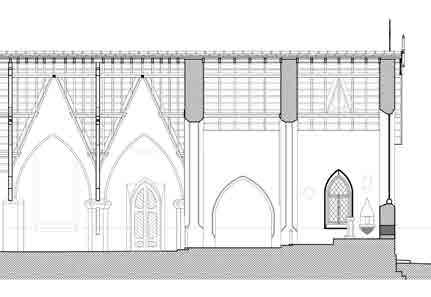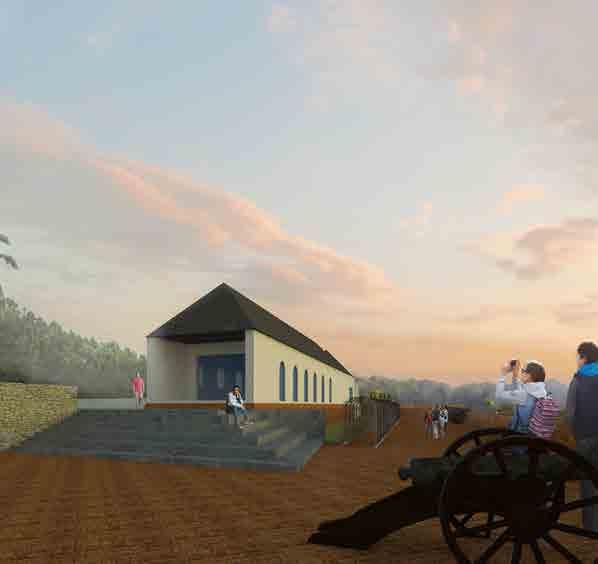portfolio lester silveira
architect, conservationist

architect, conservationist
TEACHING
PROFESSIONAL PRACTICE
01
Contemporizing Historical Precincts of the Sovabazar Sector of North Kolkata Kolkata, India
UNDERGRADUATE
Richmond Town, Bangalore, India 03 04 02 05
Repairs & Restoration of All Saints Church
Research & Documentation
Ulsoor, Bangalore, India
& Awareness Drive for Ruins of Our Lady of Mt. Carmel Chapel
Goa, India
Adaptive re-use of Aguada Lower Fort : Undergraduate Thesis
July 2024 - December 2024 TEACHING
Kolkata, India
CEPT University
Masters in Conservation and Regeneration (MCR) Programme
3rd Semester Studio
The studio focuses on learning various approaches to urban conservation that integrate existing historic fabric with contemporary needs, through the case of the historic Sovabazar Sector in North Kolkata.
Role : Studio Tutor

June 2023 - July 2024
Richmond Town, Bangalore
Client : All Saints Church
Consultant : INTACH Bangalore Chapter
Repairs and Restoration of the roof of this 154 year old Anglican Church in the heart of Bangalore. The church, designed by Architect Robert Chisholm and founded by Rev. S.T. Pettigrew was in a worriesome state, suffering from roof damages, termite infestation and dampness related issues. It also underwent several misinformed repairs in past decades.
The aim of the project was to restore the unique roofing system of the Church by sensitively removing misinformed previous layers as well structurally consolidation of the roof that included retrofitting of one of the trusses.
Role:ProjectLeadArchitect

























Longitudinal Section of the Church








August 2021 - June 2022
PROFESSIONAL PRACTICE
Ulsoor, Bangalore, India
Research and Documentation Team
INTACH Bangalore Chapter
Collaborators – Sarada Natarajan (Art Historian), Maniyarasan R (Photogrammetry), Ragul Ravichandran and team (Documentation), PeeVee (Photography)
A multi-mode approach had been undertaken to document the temple at various levels from developing a site plan and preparation of the drawings to recording the stories from the temple. The site plan was prepared using Total station surveys. The detailed measured drawings of the temple were developed through a combination of manual survey and photogrammetry.
Role:ProjectLead



Mapping of the Temple with surrounding context of settlement

Photogrammetry attempts on the Temple
SOMESHWARA TEMPLE, ULSOOR, KARNATAKA
DRAWING NO.:19
TITLE: PILLAR TYPOLOGY
SCALE:
DATE: 1:15


Chimbel, Goa, India
In support of Mount Carmel Conservation Association of Chimbel (MCCAC)
Ever since its inception in 1747-49, the Church and Convent of Our Lady of Mount Carmel has been an important part of the social fabric of the village of Chimbel, home to the first idigenous non-priveleged priestly congregation of Goan Catholics. It subsequently became a home for the destitute and then the first mental health hospital in Goa.
The site presently lies abanadoned and is on the brink of fading away from memory altogether. However, a recent movement, spurred by the formation of MCCAC, has attempted to enlist this place as a heritage site to protect it from fading into oblivion. This begins the conversation to include the ruins as part of an archaeological park that benefits the village ecology as well as socio-cultural life
Role:Documentationoforalhistories,proposalsforruinsite,assistancetocitizensfor mobilization,organizingexpertlectures,establishingofsocialmediapresence,research,etc.


The Goan report dated 11-02-2019 highlighting the story of how the ruins were brought to the notice of the officials.
Link : https://charlescorreafoundation.org/wp-content/uploads/2019/07/the-goan-everyday-the-goan-everyday-page-2.pdf




Giving a talk at the Our Lady of Livre Fevres Chapel in Chimbel to increase awareness about the ruins among the villagers. (22-10-2018)

Proposal for the Site of the church and convent
05
January - June 2016 UNDERGRADUATE
Sinquerim, Goa
UNDERGRADUATE
THESIS
The proposal aims to celebrate the history of Aguada by looking at the several layers within the site like the jail, springs, various architectural elements, fortifications and natural features of the site.
Originally, Aguada was known as ‘The Watering Place’ because of its abundant natural springs which supplied water, especially to ships enroute Goa. Besides the construction of a Fort in the 16th C., it was also famously the site of the Goa Central Jail during the 20th century. The masterplan aimed to designate areas of restoration/reuse and transformation to celebrate the various histories the site has to offer.





